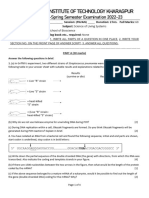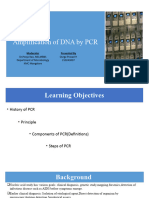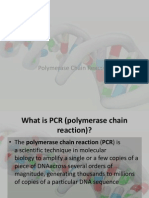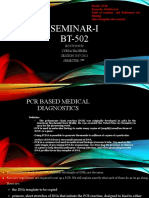0 ratings0% found this document useful (0 votes)
43 viewsThe Molecular Movement of The Polymerase Similar To Opening and Closing of The Hand
The document discusses DNA replication and polymerase chain reaction (PCR). It contains multiple choice questions about these topics. Some key points covered are:
- DNA polymerase opens and closes like a hand to allow nucleotides to enter and catalyze the reaction of adding nucleotides to the growing DNA strand.
- PCR is used to amplify specific DNA regions defined by primer binding sites, increasing the amount of that DNA region exponentially with each cycle.
- STR analysis and genetic fingerprinting rely on variations in numbers of short tandem repeats to identify individuals.
Uploaded by
Ibna HayatiCopyright
© © All Rights Reserved
Available Formats
Download as DOCX, PDF, TXT or read online on Scribd
0 ratings0% found this document useful (0 votes)
43 viewsThe Molecular Movement of The Polymerase Similar To Opening and Closing of The Hand
The document discusses DNA replication and polymerase chain reaction (PCR). It contains multiple choice questions about these topics. Some key points covered are:
- DNA polymerase opens and closes like a hand to allow nucleotides to enter and catalyze the reaction of adding nucleotides to the growing DNA strand.
- PCR is used to amplify specific DNA regions defined by primer binding sites, increasing the amount of that DNA region exponentially with each cycle.
- STR analysis and genetic fingerprinting rely on variations in numbers of short tandem repeats to identify individuals.
Uploaded by
Ibna HayatiCopyright
© © All Rights Reserved
Available Formats
Download as DOCX, PDF, TXT or read online on Scribd
You are on page 1/ 23
The molecular movement of the polymerase similar to opening and
closing of the hand:
occurs once per replication
occurs once for each nucleotide
occurs several times for each nucleotide
How can you mimic the DNA polymerase "in action"?
With your right hand.
With your left hand.
With both hands.
With either hand.
Which DNA end is represented by the upper end of the metal stick
representing the template?
5' end
3' end
Why does DNA polymerase open?
To elongate the template strand.
To allow entry of nucleotides.
To check for proper base pairing.
To catalyse the reaction.
Why does DNA polymerase close?
To allow entry of nucleotides.
To check for proper base pairing.
To catalyse the reaction.
Is it more likely that DNA polymerase is open or closed, if it has to
remove a nucleotide after wrong base pairing?
Open
Closed
The human genome has approx.:
3 million base pairs
3 billion base pairs
3 trillion base pairs
The error rate of DNA polymerase is
1: 1000
1: 1 million
1: 1 billion
Why is the error rate 6000 per replication?
Because each chromosome is present twice.
Because both strands are copied.
Because 3 Billion base pairs means 6 Billion bases.
An exonuclease can cleave nucleotides:
from the middle of a strand
from the end of a strand
The proof-reading (koreksi cetakan percobaan) function:
reduces the error rate
slows down replication
corrects about 99% of replication errors
is the reason why DNA is synthesized only in 5 to 3 direction
An error in replication:
causes a mutation
always causes disease
might cause a disease if it occurs at a sensitive site
PCR is called the polymerase chain reaction. Why is that?
Because DNA is a long chain of nucleotides.
Because the amount of product of the reaction increases in an exponential fashion.
Because 'poly' means 'many'.
Because its impact on science was like a nuclear explosion.
We're starting from one double stranded DNA molecule, with primers
that fit properly. After three rounds of PCR, how many strands of DNA
have we got?
16
3
4
8
PCR is used to:
amplify the existing amount of DNA in a test tube, without altering its sequence
produce new DNA without using a DNA template
In a PCR, the amount of product increases:
linearly
exponentially
The region/s that is/are amplified in a PCR:
are the ones that are bound by the two primers
is the one in between the two primers, including those that are bound by the two
primers
are the ones outside the two primers
is the entire DNA molecule
How many DNA molecules are present after 5 rounds of PCR on a
single DNA molecule?
16
32
64
5
What can be used as a sample for PCR?
Mucosal cells
Blood
Protein extracts
Cytoplasm
What are the advantages of PCR? It is ...
small amounts of sample can be used
fast
inexpensive
color-coded
very specific
Sickle cell anemia is caused by a point mutation, meaning:
a deletion in 1 region
the exchange of 1 base in a gene
one gene is missing
PCR is highly suitable to detect:
all types of cancer
monogenetic diseases
diseases with unknown reason
Autosomal recessive means:
the defect is on the X chromosome
a defect on only one chromosome will lead to disease
the defect is on any chromosome except X and Y
a healthy person can still be a carrier
Why is PCR very interesting when bacteria and viruses are to be
detected?
They can't be detected with other methods
Other methods might require cultivation which is risky for personnel
Cultivation required for other methods might be difficult
Which diseases can be diagnosed with PCR?
Sickle cell anemia
Chorea Huntington
Cystic fibrosis
Tuberculosis
The colorless tubes already contain lyophilized:
primers
salts
nucleotides
polymerase
The kit used in the video is a kit for detection of:
Mycoplasma
Tuberculosis
Viruses
Andrei and Can have to add:
a buffer
the samples
the polymerase
water for the negative control
The red tubes contain :
a negative control
a positive control (mycoplasma DNA)
The PCR is run for approx. 90min in:
a PCR machine
an oven
in the incubator
In the meantime, Andrei and Can prepare an agarose gel:
for sample collection
for sample separation
for sample storage
The PCR product is directly loaded onto the gel for electrophoresis
during which:
DNA is synthesized
DNA is separated due to size
negatively charged DNA migrates towards the positive pole in an electrical field
DNA becomes visible
Then, the gel is placed into an ethidium bromide solution for:
fixing
staining
development
Ethidium bromide is an intercalating dye and therefore:
is dangerous
needs to be handled with care
can cause mutations
helps to visualize DNA later
can be replaced with less dangerous GelRed if available
Upon excitation with UV light Ethidium bromide (EtBr) emits
fluorescence:
that is stronger when EtBr has intercalated
that is weaker in areas without DNA
that allows us to see the DNA bands
that is dangerous
On the final image two bands can be present in the samples and
controls:
that are of different size
that indicate mycoplasma DNA and internal control DNA
that indicate different types of mycoplasma
that indicate whether the cells are contaminated
What does STR stand for?
Small terrific repeats
Small tandem repeats
Short tandem repeats
Specific tandem repeats
Which fields have truly been revolutionized by PCR?
Forensics
Nutritional Research
Pediatrics
Crime scene investigation
How many regions are used for genetic fingerprinting by the FBI?
13
15
23
46
What is the analysis of "amelogenin" included for?
None of the above.
To show that the genetic fingerprinting has worked.
To reveal mistakes.
To determine gender.
Why are STRs so well suited for genetic fingerprinting?
They are short.
They are repetitive.
They are frequent.
They occur in different numbers.
All of the above
What does
tandem
in the term STR actually mean in terms of sequence?
short in length
identical sequence on both strands
repetitive sequence of nucleotides
a defined number of repeats
If the STR sequence on one strand reads 5'-ATGGCTTGGCGACGG-
3', how would you have to list the sequence of the complementary
strand, if you want to follow proper convention?
TACCGAACCGCTGCC
CCGTCGCCAAGCCAT
Why can you use the same primers to amplify STRs of different
lengths?
Because all STRs have the same sequence.
Because the flanking regions are identical.
How many STRs does a tetrameric repeat have?
2
3
4
6
Find the TRUE statement(s) about human karyograms.
One can never assign the origin of chromosomes in any karyogram.
One can never assign the origin of somatic chromosomes in any karyogram.
One can always assign the origin of sex chromosomes in a male karyogram.
One can always assign the origin of sex chromosomes in a female karyogram.
One can never assign the origin of sex chromosomes in any karyogram.
Which statement(s) hold true for the TPOX locus?
It has nine different alleles.
The total number of allele combinations is 9 x 9.
It is located on the lower arm of chromosome 2.
It is located on maternal and paternal chromosomes.
It is located in the thyroid proximal gene.
Find the FALSE statement(s) about STRs.
The number of STRs corresponds to the number of alleles.
The number of alleles describes the number of STR variants.
STRs have the same 5' to 3' sequence on both DNA strands.
The frequency of allele combinations varies among different populations.
An individual can have a maximum of two alleles for the same gene locus.
Forensics heavily relies on STR analysis, because:
genetic fingerprints are truly unique.
one can easily amplify STRs by PCR.
the analysis of a single gene locus suffices.
different STR analyses can readily be compared through the patterns they generate.
Homework: chapter 4
Task 1
A human body has approx. 3.72*10^(13) cells. Starting from a single
cell, the fertilized oocyte (or Zygote):
a) how many cell divisions are needed to achieve this number?
b) how many newly synthesized DNA strands does that mean? Show
your calculations.
Character Limit: 1500
Task 2
Polymerase Chain reaction (PCR) allows the amplification of any DNA
template. However, the successful amplification of only the DNA of
interest requires smart designing of the amplification primers. Imagine
you want to amplify short tandem repeats (STRs) as shown in the
figure with the given flanking DNA sequences:
Which of the following primer pairs are you going to use for
amplification of this STR region (remember, DNA sequences are
always given in the 5' to 3' direction)? Briefly explain your answer, by
referring to the PCR principle in general and directionality of
polymerization. Also include one sentence for each of the non-
applicable pairs explaining why they do not yield the desired PCR
product.
Pair 1:
5'-GGCTAGCCTTAGTAACGTTAACTG-3'
5'-AACGTAAGGCCTGTTACGATGACT-3'
Pair 2
5'-GGCTAGCCTTAGTAACGTTAACTG-3'
5'-CCGATCGGAATCATTGCAATTGAC-3'
Pair 3:
5'-GGCTAGCCTTAGTAACGTTAACTG-3'
5'-AGTCATCGTAACAGGCCTTACGTT-3'
Pair 4:
5'-CCGATCGGAATCATTGCAATTGAC-3'
5'-TCAGTAGCATTGTCCGGAATGCAA-3'
Character Limit: 1500
Task 3
STR analyses are also used in paternity testing. In general they same
principles apply as for genetic fingerprinting. In paternity testing,
however, one needs to conclude about the inheritance of genetic
fingerprints.
The figure depicts two STR analyses that were performed in parallel.
Four gene loci were analyzed for the mother, the child and the
presumptive fathers.
Please address the following questions / aspects:
a) Which of the two analyses identifies the genetic father of the child?
b) Name the gene locus based on which you did come to this
conclusion.
c) Briefly explain how the gene locus you picked allows for
identification of the genetic father and exclusion of the second male
tested.
Character Limit: 1500
You might also like
- This Study Resource Was: Polymerase Chain ReactionNo ratings yetThis Study Resource Was: Polymerase Chain Reaction4 pages
- Week_9b_Pre-Class_Reading_Guide_-_PCR__Tandem_Repeats____Genome_VariationNo ratings yetWeek_9b_Pre-Class_Reading_Guide_-_PCR__Tandem_Repeats____Genome_Variation2 pages
- PCRDNA Sequencing Forensic Pedigree (1)No ratings yetPCRDNA Sequencing Forensic Pedigree (1)35 pages
- Continuous Assessment: Concentration's Increment in Case of Insert and LigaseNo ratings yetContinuous Assessment: Concentration's Increment in Case of Insert and Ligase8 pages
- Unit 5: Methods and Techniques DNA Microarray, QPCR, RFLP, RAPD and AFLP TechniquesNo ratings yetUnit 5: Methods and Techniques DNA Microarray, QPCR, RFLP, RAPD and AFLP Techniques27 pages
- The Case of The Druid Dracula - PCR LabNo ratings yetThe Case of The Druid Dracula - PCR Lab12 pages
- Contamination Proof-Reading: Mplification Ensitivity Pecificity Obustness Utomation Ell-Free Method Ase of Set-UpNo ratings yetContamination Proof-Reading: Mplification Ensitivity Pecificity Obustness Utomation Ell-Free Method Ase of Set-Up4 pages
- D2L3 DNA Structure, Replication, PCR 2019No ratings yetD2L3 DNA Structure, Replication, PCR 201936 pages
- Performing and Interpreting PCR Assays in Canine and Feline PatientsNo ratings yetPerforming and Interpreting PCR Assays in Canine and Feline Patients9 pages
- Lecture 06 - Tools and Techniques in Biotechnology100% (1)Lecture 06 - Tools and Techniques in Biotechnology162 pages
- D1.1_DNA_Replication_Guiding_Questions_with_KeyNo ratings yetD1.1_DNA_Replication_Guiding_Questions_with_Key12 pages
- Molecular Basis of Inheritance_ Important Competency-Based Questions 2024-25No ratings yetMolecular Basis of Inheritance_ Important Competency-Based Questions 2024-259 pages
- The-principles-of-the-PCR 2021-03-22 18 - 03 - 11No ratings yetThe-principles-of-the-PCR 2021-03-22 18 - 03 - 1133 pages
- DNA Replication - IB Biology SL Grade 11No ratings yetDNA Replication - IB Biology SL Grade 119 pages
- BMOL20090 PCR and Next Gen Sequencing 2024No ratings yetBMOL20090 PCR and Next Gen Sequencing 202468 pages
- Terminology Of Biotechnology, Bio Medical Engineering, Molecular Biology, Genetics and BreedingFrom EverandTerminology Of Biotechnology, Bio Medical Engineering, Molecular Biology, Genetics and BreedingNo ratings yet
- Lyra® Sars-Cov-2 Assay Instructions For UseNo ratings yetLyra® Sars-Cov-2 Assay Instructions For Use38 pages
- Evaluation of PCR in The Molecular Diagnosis of Trichomonas Vaginalis Infection in Comparison With Other Conventional MethodsNo ratings yetEvaluation of PCR in The Molecular Diagnosis of Trichomonas Vaginalis Infection in Comparison With Other Conventional Methods8 pages
- Comparison of DNA Preservation in Permanent and Decidous Teeth in Children and AdultsNo ratings yetComparison of DNA Preservation in Permanent and Decidous Teeth in Children and Adults8 pages
- Isolation and Identification of A BegomoNo ratings yetIsolation and Identification of A Begomo11 pages
- 2021 Transmission of Helicobacter Pylori Between A Human and Two Dogs A Case ReportNo ratings yet2021 Transmission of Helicobacter Pylori Between A Human and Two Dogs A Case Report8 pages
- Minimum Validation Guidelines in Dna Profiling - v2010 0100% (1)Minimum Validation Guidelines in Dna Profiling - v2010 011 pages
- Molecular Diagnostics by Frank F. Bier, Soeren Schumacher (Auth.), Harald Seitz, Sarah Schumacher (Eds.)100% (2)Molecular Diagnostics by Frank F. Bier, Soeren Schumacher (Auth.), Harald Seitz, Sarah Schumacher (Eds.)176 pages
- Inqaba Biotec Company Profile 2022 FinalNo ratings yetInqaba Biotec Company Profile 2022 Final12 pages
- Chicken Infectious Anemia: An Emerging Immunosuppressive Viral Threat To The Poultry IndustryNo ratings yetChicken Infectious Anemia: An Emerging Immunosuppressive Viral Threat To The Poultry Industry8 pages
- ARGEN NoeDx HDV QPCR Kit Product Manual v001No ratings yetARGEN NoeDx HDV QPCR Kit Product Manual v0014 pages
- TaqPath ProAmp Master Mixes Product BulletinNo ratings yetTaqPath ProAmp Master Mixes Product Bulletin6 pages
- Wissenschafftplus Fehldeutung Virus Teil 2.de - .EnNo ratings yetWissenschafftplus Fehldeutung Virus Teil 2.de - .En11 pages
- Abbott RealTimeHighRisk_HPV_PR_v2.0 多语言No ratings yetAbbott RealTimeHighRisk_HPV_PR_v2.0 多语言91 pages
- MRK - Spring 2020 - BT502 - 2 - BC170203159No ratings yetMRK - Spring 2020 - BT502 - 2 - BC17020315911 pages
- This Study Resource Was: Polymerase Chain ReactionThis Study Resource Was: Polymerase Chain Reaction
- Week_9b_Pre-Class_Reading_Guide_-_PCR__Tandem_Repeats____Genome_VariationWeek_9b_Pre-Class_Reading_Guide_-_PCR__Tandem_Repeats____Genome_Variation
- Continuous Assessment: Concentration's Increment in Case of Insert and LigaseContinuous Assessment: Concentration's Increment in Case of Insert and Ligase
- Unit 5: Methods and Techniques DNA Microarray, QPCR, RFLP, RAPD and AFLP TechniquesUnit 5: Methods and Techniques DNA Microarray, QPCR, RFLP, RAPD and AFLP Techniques
- Contamination Proof-Reading: Mplification Ensitivity Pecificity Obustness Utomation Ell-Free Method Ase of Set-UpContamination Proof-Reading: Mplification Ensitivity Pecificity Obustness Utomation Ell-Free Method Ase of Set-Up
- Performing and Interpreting PCR Assays in Canine and Feline PatientsPerforming and Interpreting PCR Assays in Canine and Feline Patients
- Lecture 06 - Tools and Techniques in BiotechnologyLecture 06 - Tools and Techniques in Biotechnology
- Molecular Basis of Inheritance_ Important Competency-Based Questions 2024-25Molecular Basis of Inheritance_ Important Competency-Based Questions 2024-25
- Terminology Of Biotechnology, Bio Medical Engineering, Molecular Biology, Genetics and BreedingFrom EverandTerminology Of Biotechnology, Bio Medical Engineering, Molecular Biology, Genetics and Breeding
- Evaluation of PCR in The Molecular Diagnosis of Trichomonas Vaginalis Infection in Comparison With Other Conventional MethodsEvaluation of PCR in The Molecular Diagnosis of Trichomonas Vaginalis Infection in Comparison With Other Conventional Methods
- Comparison of DNA Preservation in Permanent and Decidous Teeth in Children and AdultsComparison of DNA Preservation in Permanent and Decidous Teeth in Children and Adults
- 2021 Transmission of Helicobacter Pylori Between A Human and Two Dogs A Case Report2021 Transmission of Helicobacter Pylori Between A Human and Two Dogs A Case Report
- Minimum Validation Guidelines in Dna Profiling - v2010 0Minimum Validation Guidelines in Dna Profiling - v2010 0
- Molecular Diagnostics by Frank F. Bier, Soeren Schumacher (Auth.), Harald Seitz, Sarah Schumacher (Eds.)Molecular Diagnostics by Frank F. Bier, Soeren Schumacher (Auth.), Harald Seitz, Sarah Schumacher (Eds.)
- Chicken Infectious Anemia: An Emerging Immunosuppressive Viral Threat To The Poultry IndustryChicken Infectious Anemia: An Emerging Immunosuppressive Viral Threat To The Poultry Industry
- Wissenschafftplus Fehldeutung Virus Teil 2.de - .EnWissenschafftplus Fehldeutung Virus Teil 2.de - .En

























































































